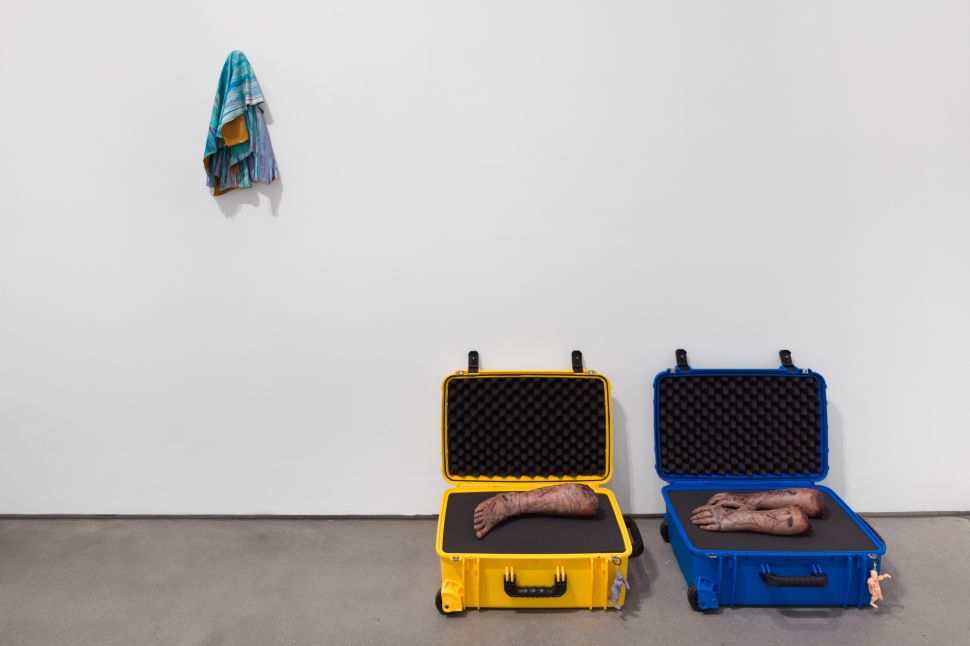
In an evolving society in which experience is becoming as symbolically crucial as products and objects, people often feel torn between the pressure to consume and a desire for spiritual growth and more meaningful personal connections. Staging this tension across the two gallery spaces in Chelsea, Marianne Boesky has mounted a thoughtful two-part show that gathers artists reflecting on the tension between these two poles that have characterized humanity’s existential and philosophical speculations from ancient times. Starting with Plato and Aristotle and culminating in Descartes, this seemingly unsolvable distinction between res cogitans and res extensa—between body (matter) and minds (spirit)—has deeply influenced the entire Western theoretical framework in approaching reality.

Preceding her upcoming solo show next September, artist Gina Bevers’s show gathers under the title “Material World” twenty-two artists who examine the power in everyday objects that surround and accompany our quotidian experience of the world. The show combines contemporary masterpieces by Robert Rauschenberg, Jack Whitten, Claes Oldenburg and El Anatsui, with those by emerging names such as the Cuban artist Sánchez Noa and Egyptian Ghada Amer, all engaging with our perception of everyday objects between consumption, between certain nostalgia, a paradoxical playfulness or comforting familiarity.
Beavers, here acting as curator, made her name with her bold, ironic and thickly textured paintings inspired by the fetishization of the body and its extensions that social media makes continuous. Building up her canvases into sculptural reliefs, she exaggerates tridimensional close-ups of lips, nails, and other body parts instrumentalized by the cosmetics industry to question ideas of beauty and self-presentation, critiquing how these concepts are mediated through social media. Pushing these forms of visual propaganda through the screen into the physical world, her work eventually comments on the performative nature of beauty routines and the societal pressures surrounding appearance.

From El Anatssui’s sculptural tapestry made by repurposing refuse to Mike Kelley’s arrangements of kitschy objects representative of American adolescence and Samara Golden’s kitchen table complete with a full breakfast, the works Beavers selected for this show relate somehow with her own practice, similarly questioning the meaning of art versus objecthood and product while confronting possible obscured histories and implications embedded within the materials, and the cultural meanings we attribute to objects as they become an extension of our process of representation of personal realities. Some other artists like Sarah Meyohas and Jared Madere, share with her a similar exploration of the possibilities of the digital realm versus physicality, experimenting with various technological and artificial-intelligence processes in their work—Meyohas by an algorithmically defined pastel plotter machine as an extension of the artist’s hand, Madere, by creating a large-scale digital photo mash-up.
SEE ALSO: ‘Tulips’ Is a Celebration of Kapp Kapp Gallery’s Fifth Year in Tribeca
“I have been noticing the effect that ads in my social media feed are having on my work, and I started to think of the idea of the products and objects that populate our lives and the different Artists who explore that through the lens of identity or critique or nostalgia,” Gina Beavers told Observer at the show’s opening. “As I was compiling the works, I realized ‘material’ could also refer to the extraordinary range of experimentation with materials among the works in the show.”

In the other gallery space, the legendary gallerist Marianne Boesky herself curated a more poetic show, “Sublime Spirit,” featuring twelve artists exploring the timeless human desire to escape from the physical world we know for another idyllic spiritual dimension, an ‘Arcadia’ where humans and other entities still coexist in perfect harmony. The show collects precious gems of unique spiritual and poetic power from lesser-known yet equally exciting artists of diverse geographical and cultural backgrounds, where the romantic sense of sublime materializes between awe, fascination and terror in front of inscrutable natural forces.

An example is the bodily sensual abstraction and symbolic sculptures by South African artist Nicola Bailey, where the sublime manifests in the relation between humans and animals. Similarly, Hadi Falapishi’s childish animals speak to the unaffected awe with which young people experience nature.
Drawing from a timeless fascination with a wilder primordial past, the vibrantly immersive abstract paintings by artists Brazilian artists Luiza Gottschalk, Mirela Cabral, and Thalita Hamaoui, and Lebanese artist Nathalie Khayat, share a use of dynamic movements of colors to suggest a perpetual reinvention in the elements as the seasons progress, in the natural circles. Others, like Antonio Ballester Moreno and Mari Ra, focus instead on reducing their imaginary landscapes into minimal geometric elements and color fields that suggest an inner logic in nature. Leaning towards Transcendentalism, they react against prevailing intellectualism and materialism, which translate into a limiting categorizing reality, advocating a deeper spiritual connection to nature.

Ultimately, if “Material World” compels viewers to confront the physical constraints of our experiences and desires in this world, as well as the societal dynamics that govern human-centric circles, “Sublime Spirit” serves as a reminder that humans are part of the natural world and that the wilderness we yearn for also yearns for us.
“Material World” and “Sublime Spirit” are on view at the gallery’s Chelsea location until July 26.


